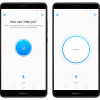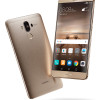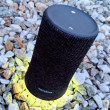Review: Huawei Mate 9
Nov 28, 2016, 8:00 AM by Eric M. Zeman

The Mate 9 is Huawei's flagship handset for 2016 and it's an impressive device. This over-sized Android smartphone comes in an attractive glass-and-metal form with top specs buried within. It shows that Huawei is taking the competition seriously. Here is Phonescoop's in-depth review of the Mate 9.
Is It Your Type?
The Mate 9 is Huawei's big-screen flagship for the year. It boasts a gorgeous design, the best-possible specs, and blistering performance to match. The Huawei Mate 9 is a worthy contender in the unlocked market and goes toe-to-toe with the best handsets from Apple, Samsung, and others.
Body
Huawei's Mate 9 is an impressive piece of hardware. The phone is a high-end bit of kit that represents the best from Huawei's design, engineering, and manufacturing teams. It is easily the best I've seen from Huawei and demonstrates that the company has learned a lot over the last few years.
The Mate 9 features a unibody aluminum chassis with curved-edge glass. It has gently rounded corners and a classy face. I appreciate the mix of materials and Huawei selected fine-quality components to form the outer shell. The phone features finely polished chamfers, front and back. The side edges have a totally hot brushed metal texture that I wish adorned the back surface as well; instead, the back is what I'd call plain metal. Huawei gave the plain metal rear surface a gentle curve so it tapers out just a bit towards the edges. The Mate 9 comes in five colors, including gold, dark gray, brown, silver, and white. Our silver review unit is refined all the way.
Huawei's Mate series is known for its over-sized dimensions and the Mate 9 carries that torch onward and upward. Dang, this phone is gigantic, thanks to the massive slab of a screen. It's a hand-stretching 6.2 inches tall by 3.11 inches wide. The curved rear panel and smoothed-over side edges help hand-feel somewhat, but the Mate 9 is a huge phone that constantly requires two hands to use effectively. If big phones are your bag, you'll appreciate the Mate 9. For people who are wary of huge and heavy handsets, the Mate 9 may prove to be too much. This phone will push pockets to their limits. It worked in some jeans, but not others; phone fit will depend on how tight you like your pants.
There's no doubt the Mate 9 is Huawei's best effort when it comes to quality. The phone feels every bit the flagship it is. The aluminum has a weight to it that conveys strength and gravitas; the Mate 9 is to be taken seriously. The curved-edge glass is fitted into place perfectly with flawless seams all around. This is as fine a piece of hardware as you'll find anywhere.
Bezels are practically non-existent on the Mate 9's huge face. The forehead and chin bezels above and below the display are incredibly slim, and the side bezels so thin as to be invisible. A shiny metal grille above the black glass reveals the location of the earpiece speaker. A small sensor and the user-facing camera are positioned to its right. There are no buttons in the bezel below the display. You'll notice Huawei's logo there, but that's it.
The only hardware buttons are tucked into the right edge of the phone. The lock button is rather small, but has enough of a profile that your thumb can easily find it by feel. Travel and feedback are great. The volume toggle is closer to the top of the phone and boasts the same profile and action as the lock button. I wish the buttons had different textures to help differentiate them. You'll find the SIM tray buried in the left edge. The tray itself accommodates either two SIM cards, or one SIM card and one memory card. I like that the tray is sturdy and strong. Small antenna lines are another element you'll notice on the side edges. Each of the four corners includes a color-matched bit of plastic.

Music lovers will be happy to find a 3.5mm headphone jack on the Mate 9's top edge. Huawei also stuck an IR blaster up there for interacting with television sets. The bottom edge is pleasingly symmetrical. The USB-C port is in the middle, flanked by two exposed screws and then a series of vertical slits in the metal — all of which are spaced evenly apart. The balanced design makes my eyes happy.

Aluminum stretches across the Mate 9's wide back surface. The phone thins out just a bit closer to the sides. It's easy to spot the Mate 9's only design weakness: thin plastic panels at the top and bottom. Such panels are common to lower-end metal-body phones, providing an area for the type of antennas that might be used on a non-metal phone. The colors of the Mate 9's plastic panels don't quite match the metal, and neither does the texture. The good news here is that Huawei fitted them in perfectly; there are no gaps and the seam is tight where the panels sit between the outer frame and metal covering.
The battery is sealed in and cannot be removed.
The Leica-branded, double-camera module is accompanied by a dual-LED flash. I'm surprised by how tiny the fingerprint sensor is. It's a small, circular indentation below the camera. The indentation is deep, making the sensor easy to find by feel.

I'm really impressed by the Huawei Mate 9 hardware, and I suspect you will be, too. It's a high-end handset that gets almost everything right. The biggest detractor to the hardware is the sheer size, which might be offputting to some.
Screen
Surprisingly, the Mate 9's 5.9-inch display carries only full HD (1080p) resolution and not quad HD (2K). The panel is bright and colorful, of that there's no doubt, but a screen this large would benefit from more pixels. I was very pleased with the amount of light that comes from the screen. I had no trouble using it indoors or outdoors. The automatic brightness control worked really well, especially when transitioning between bright and dark environments. Colors are mostly accurate. Viewing angles are excellent. The resolution does hinder the Mate 9's prowess as a virtual reality machine. It's simply not as good as phones that have quad HD screens. Aside from VR, however, it does just fine.
Signal
Huawei sells the Mate 9 unlocked and it boasts support for the LTE networks of AT&T and T-Mobile. Specifically, it supports LTE in bands 1, 2, 3, 4, 5, 7, 8, 9,12, 17, 18, 19, 20, 26, 28, and 29. I tested the Mate 9 on AT&T's network and T-Mobile's network in and around New York City and found the device performed very well when compared to other phones.
The Mate 9 was apt to connect calls quickly and did not drop any calls during a highway trip. The phone easily patched calls through in even the worst coverage environments. As for data, mobile broadband speeds were very, very good. The Mate 9 did well when it came to Google Search, checking email, following my Twitter or Instagram feeds, or catching up on Facebook. The phone had no trouble streaming media from YouTube and Spotify. It gets the job done, for sure.
Sound
The Mate 9 is a decent voice phone, though I've heard better. The earpiece can push out plenty of sound, but it's often thin and shrill. Voices come through with a piercing quality that grated my ears. Even so, I was able to hear and understand calls even in relatively noisy spaces, such as coffee shops and busy city streets. It will distort at the max volume setting. People I spoke to through the Mate 9 said I sounded OK.
The speakerphone, which fires downward out the bottom, is also ridiculously loud. The good news is that it produces more well-rounded sound and is often clearer and more palatable than the earpiece. I didn't hear any distortion via the speakerphone, even when set to the max. Ringers and alerts are crazy loud. The vibrate alert is acceptable.
Huawei gave the Mate 9 two-speaker sound, but don't call it stereo. Similar to what HTC did with the 10, the Mate 9 pushes high frequencies out the earpiece speaker and low frequencies out the lower speaker. The resulting sound is fine if you're holding the phone normally (in portrait orientation). Turn the phone on its side to watch some video, however, and the sound becomes unbalanced.
Battery
Huawei somehow managed to endow the Mate 9 with a 4,000 mAh battery. This is an absolutely gigantic power cell for a smartphone and it delivers monstrous battery life. The Mate 9 routinely chewed its way two days on a single charge while running full tilt. During my tests, I kept the screen brightness up, all the radios on, and spent gobs of time streaming media over a mix of WiFi and LTE. Huawei's restraint with the screen resolution pays dividends in battery life. Many will decide the trade-off is worth it.
The Mate 9 includes two power management tools, but I don't think you'll need either.
Last, the Mate 9 supports Huawei's rapid charging technology. The company claims the phone can ingest a full-day's charge in just 20 minutes. I think that's exaggerating a bit, but at least the phone ships with the needed fast charger.
Bluetooth, NFC, GPS, WiFi
Huawei didn't skimp on the Mate 9's secondary radios. Bluetooth, for example, runs version 4.2 (including Low Energy mode) and supports headsets, speakers, PCs, and cars. I connected the phone to all these without issue. Phone calls passed through my car's hands-free system sounded better than they do through the earpiece. Music took on a pleasant timbre when pushed to a Bluetooth speaker.
The included NFC radio was helpful in pairing with other devices, and supporting Android Pay for mobile payments.
The Mate 9 supports both GPS and GLONASS for location data. Together with Google Maps, it was a fine tool for navigating the world around me. Not only did the phone locate me in a blink, but location was incredibly accurate. Moreover, the little blue arrow in Google Maps that indicates the direction you're facing was the most accurate and responsive I've ever seen on any phone.
Wi-Fi? The Mate 9's dual-band 802.11a/b/g/n/ac radio crushed it.
Comments
good review


















 5 Best Unlocked Smartphones
5 Best Unlocked Smartphones
 Hands On with the Huawei Mate 9
Hands On with the Huawei Mate 9
 Huawei Mate 9 Gains Amazon Alexa Today
Huawei Mate 9 Gains Amazon Alexa Today
 Huawei Mate 9 Coming to U.S.
Huawei Mate 9 Coming to U.S.
 Huawei Mate 9
Huawei Mate 9



